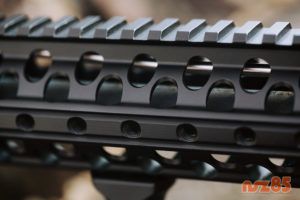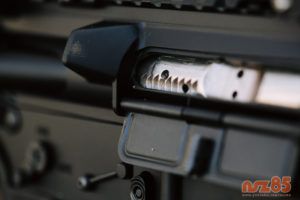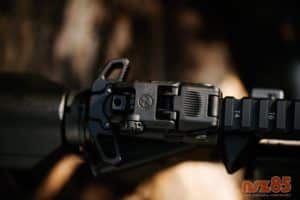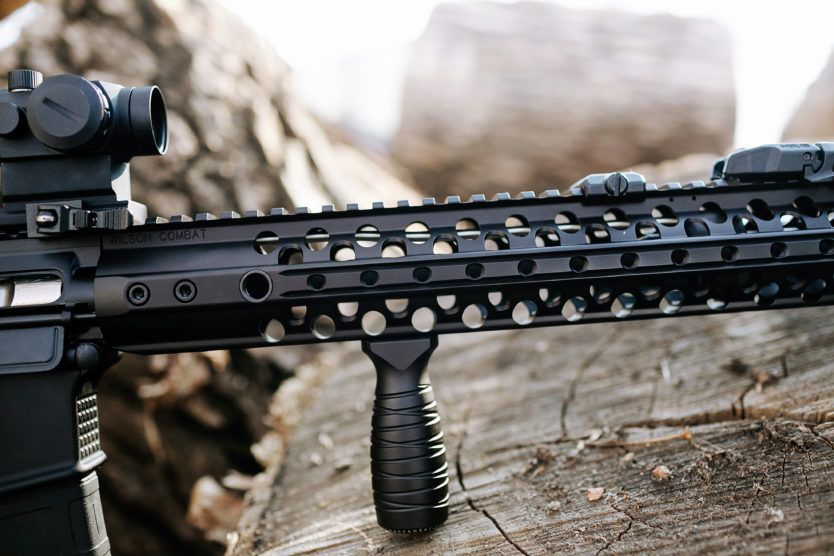Custom building an AR-15 upper receiver is not only rewarding, but it gives you the ability to choose exactly what components will be in your custom AR-15. You will have full control over the way it looks and how much it will cost. I prefer to spend the majority of my AR-15 build budget on the upper receiver mainly because it is from where most of the weight, ergonomics, and accuracy derive.
AR-15 Upper Receiver Custom Builds

There are far too many combinations of components and accessories for me to cover every kind of AR-15 upper receiver build. However, a lot of the aspects and procedures are the same in each upper receiver build. I will begin this “How to Build an AR-15 Upper Receiver” series of articles with a list and overview of the parts that typically make up an AR-15 upper receiver. I will also include a list of the parts that I chose to use in my personal AR-15.
Before we get started, please understand that you should always be responsible and check your state and local laws for this type of project. I, and The Arms Guide overall, assume no responsibility for any laws or regulations you may violate or any injuries you may cause. You are responsible for your safety and for following your local laws.
AR-15 Upper Receiver Components
Ok, with that out of the way, let’s get started on going over the components that make up the AR15 upper receiver.
What is an Upper receiver?
An upper receiver is a part that attaches to the AR-15 lower receiver and holds all of the other components. You may purchase an upper receiver either stripped or completed. For the purpose of this series of articles, I will be covering how to install components into a stripped upper receiver.
Barrel
The barrel is installed into the front of the upper receiver and is arguably going to play the biggest role in the overall accuracy of your Rifle. AR-15 Barrels come in a number of different lengths, profiles (shape), types and also determine what length gas system you will utilize. It is important to note that any barrel measuring shorter than an overall length of sixteen inches will deem the AR-15 an NFA item known as a short-barreled rifle (SBR). This is highly illegal without the required additional ATF paperwork and a $200 federal tax stamp. For this series of articles, I will be covering how to build an AR-15 upper receiver with a standard sixteen-inch barrel.

Gas block and tube
The different gas system types (rifle, mid-length, carbine) refer to where the gas port is located on the barrel. The length of the gas system is the deciding factor for what length gas tube you will need as well. The gas block goes over the barrel and usually under the rail/handguard. The gas tube goes into the gas block and into the upper receiver. If you decide you want an A2 style front sight instead of a gas block, the A2 front sight also serves as your gas block. Gas travels from behind the bullet exiting the barrel, through the gas port, into the gas block, down the gas tube and exits into the gas key on the bolt carrier. This gas pressure is what pushes the BCG (bolt carrier group) back into the buffer allowing for ejecting the spent casing and chambering a new round.
Rail or Handguard
AR15 Rails and handguards fit over the barrel and are installed for the purpose of protecting your hands from the heat generated from firing the AR-15 and giving you the ability to attach accessories such as optics, sights, grips and flashlights.
Bolt carrier group (BCG)
This component is what controls the feeding, firing, and ejection of the ammunition in your AR-15. A Bolt Carrier Group (BCG) is where the firing pin, bolt, extractor and ejector are held.

Charging handle
A Charging handle is what you will use to “charge” the AR-15. Think of it as racking the slide on a hand gun to load a round into the chamber; only instead of a slide, it is a charging handle. The charging handle does not move when the AR-15 is fired. It is only used when the BCG needs to be moved to the open position to clear a malfunction or load a round into the chamber.
Forward assist
If your bolt does not fully close, a few whacks on the forward assist should force it into place. Some upper receivers do not have a forward assist as some users either do not feel they perform a necessary function, or do not like their appearance. I will be covering how to install a forward assist onto the AR-15 upper receiver.
Ejection port cover
In the closed position, the ejection port cover protects the upper and BCG from dust, dirt and other debris. The only function of the ejection port cover is to be open or closed. A cover has to be manually closed, but it opens automatically when the BCG moves to the rear. Some AR-15 upper receivers do not have an ejection port cover but I will be covering how to install one.
Muzzle brake/compensator/flash hider
This is attached to the end of the barrel and assists with reducing muzzle rise, muzzle flash, and perceived recoil. The A2 “bird cage” style break is one of the most popular styles. The best AR-15 muzzle brakes are reviewed for you here

My AR-15 Upper Receiver Components
If you see something you like on my personal build, want some ideas for building your own upper receiver, or just are just curious; here is a list of the items that make up my AR-15 upper receiver (and will be discussed in the follow up posts in this series):

Upper receiver: MEGA Arms forged
Barrel: Parkerized 16″ mid-length FNH Spikes Tactical cold hammer forged (CHF) 1:7 twist
Rail: Free floating 12.6″ Wilson Combat TRIM rail
BCG: FailZero NiB coated M16 BCG
Charging handle: Rainier Arms/AXTS ambidextrous Raptor
Muzzle break/comp: Battle Comp 1.0
Sights: Magpul BUIS Gen2
Optic: Aimpoint PRO 2MOA
Foregrip: Magpul AFG2
Light: Streamlight TLR-1 HL (600 lumens)
Now that you have a better understanding of what each part is that makes up an AR-15 upper receiver, what its function is and what parts I chose for my personal AR-15, you will be all set for next week’s article on what specific tools and components you will need to build one. Stay tuned.


